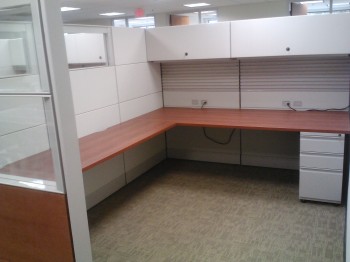 Cubicles have an image problem. In the minds of many workers, cubicles are strongly associated with boredom, lack of creativity, and lack of personality.
Cubicles have an image problem. In the minds of many workers, cubicles are strongly associated with boredom, lack of creativity, and lack of personality.
Nothing could be farther from the truth.
The Herman Miller company — the same Herman Miller company that makes the Ethospace cubicles EthoSource refurbishes and sells today — came up with something called an “Action Office” in the lates 1960s.
Robert Propst, head of research for Herman Miller, had spent years studying how people work. In the pre-cubicle days, office workers generally worked at desks in rows in a big room, much like a traditional classroom. They had a small workspace with an in box and an out box.
Propst thought that people would be more productive if they had more room to spread their projects out and could work in their own style — whatever that style was. He envisioned a workstations with plenty of room for workers to create their own organization for their work, with options like drawers or shelves or files or wall space where they could pin things.
The Action Office had desktop space, but could also let workers create a workspace where they could stand to work, a healthier option that could make workers feel more energetic. There would be partitions, not only to provide wall space for creative work, but also to give workers some privacy.
The Action Office could be changed at will, so that a workroom could include some collaborative space, some private space for focused concentration, and some space where people could see one another and communicate easily while still having enough privacy to stretch or take a phone call.
Admittedly, many companies fail to explore all the creative options with cubicles.
 That’s a problem of vision, not a problem with cubicles. EthoSource designers help companies determine the best way to use their workstations. The result can range from a traditional office look to something very different.
That’s a problem of vision, not a problem with cubicles. EthoSource designers help companies determine the best way to use their workstations. The result can range from a traditional office look to something very different.
At the end of the day, it’s all in how you use them.
When you plan your office space, consider you company’s need for private, collaborative, and community space. Consider the way sound works in your office — salespeople or customer care reps on the phone have different needs when it comes to sound than people working on tasks requiring lots of math or coding.
Think of your office culture and the flow of traffic in your office as well.
Finally, give serious thought to taking advantage of the complete furniture management services EthoSource provides. We’ve created just-right experiences for many companies across the nation, and we can do the same for you.
Enjoy some of our case studies:

